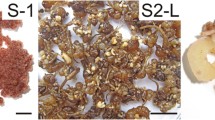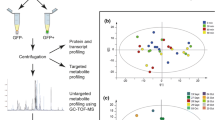Summary
The induction of metabolic changes in suspension cultured cells of Catharanthus roseus upon elicitation has been investigated. Addition of a yeast glucan preparation to the growth medium resulted in induction of phenylalanine ammonia lyase. Phosphate uptake and metabolism of elicited cells was followed by 31P nuclear magnetic resonance. The uptake rate of Pi from the medium by oxygenated cells of C. roseus was reduced immediately after elicitation. Despite this reduced Pi uptake elicited cells had significantly increased amounts of ATP (twofold increase within 6 h). Cytoplasmic levels of Pi, phosphomonoesters, and Uridine Diphasphate glucose (UDP-Glc) were unaffected by eliciation. Furthermore, the cytoplasmic and vacuolar pH remained constant after addition of elicitor.
Similar content being viewed by others
References
Brodelius, P. Elicitation of cultivated plant cells as a tool in biotechnology and basic biochemistry. Adv. Mol. Cell. Biol. 15A:317–338; 1996.
Brodelius, P.; Deus, B.; Mosbach, K., et al. Immobilized plant cells for the production and transformation of natural products. FEBS Lett. 103:93–97; 1979.
Brodelius, P.; Funk, C.; Häner, A., et al. A procedure for the determination of optimal chitosan concentrations for elicitation of cultured plant cells. Phytochemistry 28:2651–2654; 1989.
Brodelius, P.; Vogel, H. J. A phosphorus-31 nuclear magnetic resonance study of phosphate uptake and storage in cultured Catharanthus roseus and Daucus carota plant cells. J. Biol. Chem. 260:3556–3560; 1985.
Cheong, J. J.; Hahn, M. G. A specific high-affinity binding site for the hepta-β-glucoside elicitor exists in soybean membranes. Plant Cell 3:137–148; 1991.
Collinge, M. A.; Brodelius, P. E. Dynamics of benzophenanthridine alkaloid production in suspension cultures of Eschscholtzia californica after treatment with a yeast elicitor. Phytochemistry 28:1101–1104; 1989.
Cosio, E. G.; Frey, T.; Ebel, J. Identification of a high-affinity binding protein from a hepta-β-glucoside phytoalexin elicitor in soybean. Eur. J. Biochem. 204:1115–1123; 1992.
Dixon, R. A.; Paiva, N. L. Stress-induced phenylpropanoid metabolism. Plant Cell 7:1085–1097; 1995.
Ebel, J.; Stäb, M. R.; Schmidt, W. E. Induction of enzymes of phytoalexin synthesis in soybean cells by fungal elicitor. In: Neumann, K.-H.; Barz, W.; Reinhard, E., eds. Primary and secondary metabolism of plant cell cultures. Heidelberg, Germany: Springer-Verlag; 1985:247–254.
Farmer, E. E.; Pearce, G.; Ryan, C. A. In-vitro phosphorylation of plant plasma membrane proteins in response to the proteinase inhibitor inducing factor. Proc. Natl. Acad. Sci. USA 86:1539–1542; 1989.
Funk, C.; Gügler, K.; Brodelius, P. Increased secondary product formation in plant cell suspension cultures after treatment with a yeast carbohydrate (elicitor). Phytochemistry 26:401–405; 1987.
Gügler, K.; Funk, C.; Brodelius, P. Elicitor-induced tyrosine decarboxylase in berberine synthesizing suspension cultures of Thalictrum rugosum. Eur. J. Biochem. 170:661–666; 1988.
Guo, Z. J.; Ohta, Y. Effect of ethylene biosynthesis on the accumulation of 6-methoxymelein induced by elicitors in carrot cells. J. Plant Physiol. 144:700–704; 1994.
Linsmaier, E. M.; Skoog, F. Organic growth factor requirements of tobacco tissue cultures. Physiol. Plant. 18:100–127; 1965.
Lorient, R.; Coulomb, C.; Pradet, A. Adenine nucleotide analysis in pepper leaves during systemic induction of resistance to Phytophthora capsici L. and after inoculation with this pathogen. Agronomie 7:807–812; 1987.
Lundberg, P.; Harmsen, E.; Ho, C., et al. NMR studies of cellular metabolism. Anal. Biochem. 191:193–222; 1990.
Moreno, P. R. H.; Poulsen, C.; van der Heijden, R., et al. Effects of elicitation on different metabolic pathways in Catharanthus roseus (L.) Don cell suspension cultures. Enzyme Microb. Technol. 18:99–107; 1996.
Ni, W.; Fahrendorf, T.; Ballance, G. M., et al. Stress responses in alfalfa (Medicago sativa L.). XX. Transcriptional activation of phenylpropanoid pathway genes in elicitor-induced cell suspension cultures. Plant Mol. Biol. 30:427–438; 1996.
Nishi, A. Elicitor-induced production of secondary metabolites in higher plants. Yakugaku Zasshi 113:847–860; 1993.
Ojalvo, I.; Rokem, J. S.; Navon, G., et al. 31P NMR study of elicitor treated Phaseolus vulgaris cell suspension cultures. Plant Physiol. 85:716–719; 1987.
Osswald, W. F.; Zieboll, S.; Elstner, E. F. Comparison of pH changes and elicitor induced production of glyceollin isomers in soybean Glycine max cultivar horosoy-63 cotyledons. Z. Naturforsch. 40c:477–481; 1985.
Park, H. H.; Hakamatsuka, T.; Sankawa, U., et al. Rapid metabolism of isoflavonoids in elicitor-treated cell suspension cultures of Pueraria lobata. Phytochemistry 38:373–380; 1995.
Pasquali, G.; Goddijn, O. J. M.; de Waal, A., et al. Coordinated regulation of two indole alkaloid biosynthetic genes from Catharanthus roseus by auxin and elicitors. Plant Mol. Biol. 18:1121–1131; 1992.
Pelissier, B.; Thibaud, J. B.; Grignon, C., et al. Cell surfaces in plant-microorganism interactions VII. Elicitor preparations from two fungal pathogens depolarize plant membranes. Plant Sci. 46:103–109; 1986.
Ratcliffe, R. G. In vivo NMR studies of higher plants and algae. In: Callow, J. A., ed. Advances in botanical research. Vol. 20. London: Academic Press; 1994:43–123.
Ryan, C. A. Oligosaccharides as recognition signals for the expression of defensive genes in plants. Biochemistry 27:8879–8883; 1988.
Strasser, H.; Matern, U. Minimal time requirement for lasting elicitor effects in cultured parsley Petroselinum hortense cells. Z. Naturforsch. 41C:222–227; 1986.
Vazquez-Flota, F.; Moreno-Valenzuela, O.; Miranda-Ham, M. L., et al. Catharanthine and ajmalicine synthesis in Catharanthus roseus hairy root cultures: medium optimization and elicitation. Plant Cell Tissue Organ Cult. 38:273–279; 1994.
Vogel, H. J.; Brodelius, P. An in vivo 31P NMR comparison of freely suspended and immobilized Catharanthus roseus plant cells. J. Biotechnol. 1:156–170; 1984.
Vogel, H. J.; Brodelius, P.; Lilja, H., et al. Nuclear magnetic resonance studies of immobilized cells. In: Mosbach, K., ed. Methods in enzymology. Vol. 135. San Diego; Academic Press; 1987:512–528.
Ward, E. R.; Uknes, S. J.; Williams, S. C., et al. Coordinate gene activity in response to agents that induce systemic acquired resistance. Plant Cell 3:1085–1094; 1991.
Author information
Authors and Affiliations
Rights and permissions
About this article
Cite this article
Lundberg, P., Vogel, H.J. & Brodelius, P.E. A phosphorus-31 nuclear magnetic resonance study of elicitor-mediated metabolic changes in Catharanthus roseus suspension cultures. In Vitro Cell.Dev.Biol.-Plant 33, 301–305 (1997). https://doi.org/10.1007/s11627-997-0055-1
Received:
Accepted:
Issue Date:
DOI: https://doi.org/10.1007/s11627-997-0055-1




